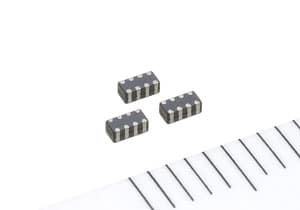The new TCM1210U500-2P from TDK Corporation is a wideband, thin-film, common-mode filter for EMI suppression in DisplayPort interfaces. This new filter works as an EMI countermeasure on high-speed data transmission lines in notebook computers, audio-visual equipment, and other electronic devices. With dimensions of 1.2 mm (L) x 1.0 mm (W) x 0.6 mm (H), this product has been crafted expressly for suppressing noise on DisplayPort connections, a new standard for signal transmission between computers and audio-visual equipment and display monitors at speeds that exceed even HDMI (2.25 Gbits/s). A DisplayPort link uses up to four lines, each rated for 2.7 Gbits/s for a total transfer rate of 10.8 Gbits/s.Utilizing TDK’s proprietary thin-film magnetic head technology, this device has a cut-off frequency of 8.0 GHz, an impedance of 50 Ω (at 100 MHz), a rated current of 100 mA, and a rated voltage of 10 V. Consequently, the TCM1210U500-2P offers effective noise control without degrading the outstanding transmission characteristics of high-speed differential transmission line signals. Look for more product information on the TDK website.Filters are crucial to achieving EMC and common filters are just one of the many products discussed on the InterferenceTechnology.com Filters Forum. A visit to the Forum keeps you up-to-date on any filter problems encountered and suggested solutions, and it’s just a few keystrokes away. Try it now.
Thin-Film Common Mode Filter Targets Use in DisplayPort






